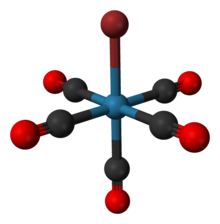 | |
| Names | |
|---|---|
| IUPAC name Bromidopentacarbonylrhenium | |
| Identifiers | |
| CAS Number | |
| 3D model (JSmol) | |
| ChemSpider | |
| ECHA InfoCard | 100.034.607 |
| EC Number |
|
| PubChem CID | |
| CompTox Dashboard (EPA) | |
InChI
| |
SMILES
| |
| Properties | |
| Chemical formula | Re(CO)5Br |
| Molar mass | 406.16 g/mol |
| Appearance | colorless |
| Melting point | sublimes 85-90 °C (0.2 mm Hg) |
| Solubility in chlorocarbons | soluble |
| Hazards | |
| GHS labelling: | |
| Pictograms |  
|
| Signal word | Danger |
| Hazard statements | H301, H311, H315, H319, H331, H335 |
| Precautionary statements | P261, P264, P270, P271, P280, P301+P310, P302+P352, P304+P340, P305+P351+P338, P311, P312, P321, P322, P330, P332+P313, P337+P313, P361, P362, P363, P403+P233, P405, P501 |
| Except where otherwise noted, data are given for materials in their standard state (at 25 °C , 100 kPa).
| |
Bromopentacarbonylrhenium(I) is an inorganic compound of rhenium, commonly used for the syntheses of other rhenium complexes.
Preparation
Bromopentacarbonylrhenium(I) is commercially available. It is also easily and inexpensively synthesized by the oxidation of dirhenium decacarbonyl with bromine:
- Re2(CO)10 + Br2 → 2 ReBr(CO)5
It was first prepared by the "reductive carbonylation" of rhenium(III) bromide:
- ReBr3 + 2 Cu + 5 CO → BrRe(CO)5 + 2 CuBr
Copper(I) bromide is a byproduct.
Reactions
Bromopentacarbonylrhenium(I) is a precursor to other rhenium complexes. It reacts with zinc and acetic acid to give pentacarbonylhydridorhenium (HRe(CO)5).
- Re(CO)5Br + Zn + HO2CCH3 → ReH(CO)5 + ZnBrO2CCH3
It also reacts with tetraethylammonium bromide in diglyme to give 2, an important precursor to compounds containing the rhenium tricarbonyl fragment.
Heating bromopentacarbonylrhenium(I) in water give the triaquo complex:
- ReBr(CO)5 + 3 H2O → Br + 2 CO
This route avoids the formation of the tetraethylammonium bromide byproduct, which is often difficult to remove from reaction mixtures.
References
- Steven P. Schmidt; William C. Trogler; Fred Basolo (1990). "Pentacarbonylrhenium Halides". Inorganic Syntheses. Vol. 28. pp. 154–159. doi:10.1002/9780470132593.ch42. ISBN 9780470132593.
- W. Hieber; Hans Schulten (1939). "XXX. Mitteilung über Metallcarbonyle. Über Rhenium-Kohlenoxyd-Verbindungen". Zeitschrift für anorganische und allgemeine Chemie. 243 (2): 164–173. doi:10.1002/zaac.19392430205.
- Michael A. Urbancic; John R. Shapley (1990). "Pentacarbonylhydridorhenium". Inorganic Syntheses. Vol. 28. pp. 165–8. doi:10.1002/9780470132593.ch43. ISBN 9780470132593.
- R. Alberto; A Egli; U. Abram; K. Hegetschweiler; V. Gramlich & P. A. Schubiger (1994). "Synthesis and Reactivity of 2. Formation and Structural Characterization of the Clusters and by alkaline titration". J. Chem. Soc., Dalton Trans. (19): 2815–2820. doi:10.1039/DT9940002815.
- N. Lazarova; S. James; J. Babich & J. Zubieta (2004). "A convenient synthesis, chemical characterization and reactivity of Br: the crystal and molecular structure of ". Inorganic Chemistry Communications. 7 (9): 1023–1026. doi:10.1016/j.inoche.2004.07.006.
| Rhenium compounds | |||||
|---|---|---|---|---|---|
| Rhenium(0) |
| ||||
| Rhenium(I) |
| ||||
| Rhenium(II) | |||||
| Rhenium(III) | |||||
| Rhenium(IV) | |||||
| Rhenium(V) | |||||
| Rhenium(VI) | |||||
| Rhenium(VII) |
| ||||